This video by Roy Troutman shows a Tibicen cicada nymph emerge from the ground.
Annual cicada nymph emerging from burrow. from Roy Troutman.
This video by Roy Troutman shows a Tibicen cicada nymph emerge from the ground.
Annual cicada nymph emerging from burrow. from Roy Troutman.
Cicadas breathe through apertures along the side of their body called spiracles. This video of a Tibicen by Roy Troutman shows the opening and closing of a spiracle.
Adult Cicada breathing from Roy Troutman on Vimeo.
The fungus Massospora cicadina preys on Magicicadas cicadas. This is particularly interesting because the fungus is able to prey upon them in spite of their long 17 year life cycle (apparently fungi are not phased by prime numbers).
When the fungus destroys the abdomen of male cicadas, they will behave like female cicadas and flick their wings in response to the songs of male cicadas, and attempt to mate with other males.
A photo by Roy Troutman from Brood XIV (2008):
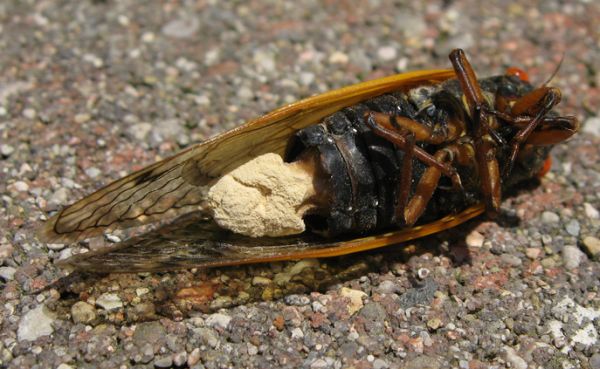
Two photos by Dan Mozgai from Brood II (2013):
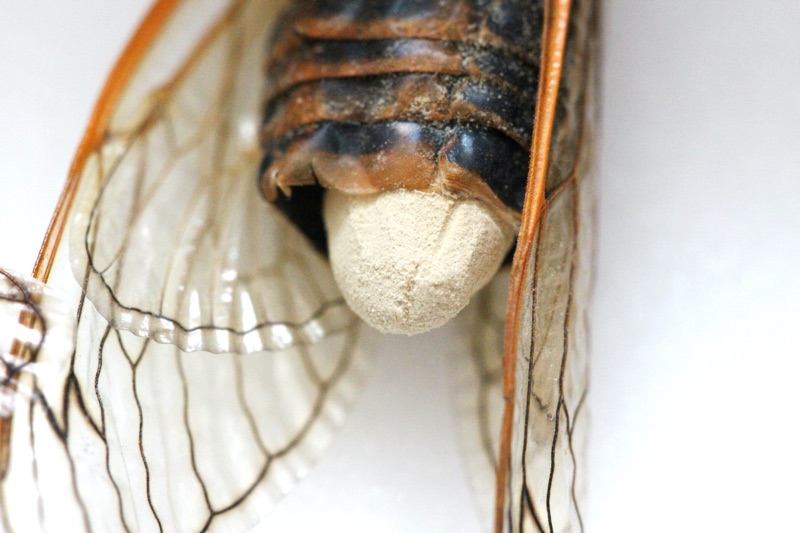
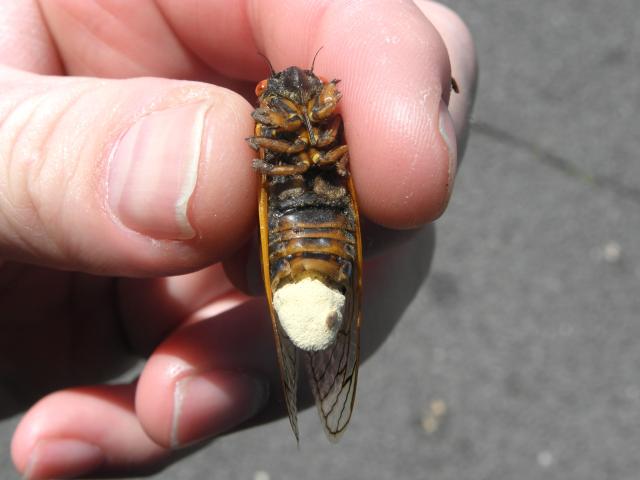
magicicada fungus (massospora cicadina) from Roy Troutman on Vimeo.
New from 2017: the Massospora cicadina viewed under a microscope.
Examining & measuring #Massospora spores for #MSA2017 in GA. Here's M. cicadina resting spores (#BroodVI, 2017). #fungi @MSAFungi @zygolife pic.twitter.com/b78R9VwDgP
— Matt Kasson (@kasson_wvu) July 12, 2017
During the Brood II emergence in 2013, Elias Bonaros, Roy Troutman and I spent some time experimenting with coercing male Magicicada to call in response to finger snaps, which mimic the snap of a female cicada’s wings. This trick works fairly well with Magicicada, and can quickly be mastered once you work out the timing. Fingers, wall switches, and the zoom button on my Sony video camera do a good job at mimicking the snap of a females wings.
Magicicada cassini responding to fingersnaps from Cicada Mania on Vimeo.
I also recorded their calls in terms of decibels to see just how loud they could get. They can get very loud, but not as loud as a rock concert (see this db chart).
Magicicada cassini calling at 109db in Colonia NJ from Cicada Mania on Vimeo.
Magicicada cassini chorusing center peaking at 85db from Cicada Mania on Vimeo.
Here are two videos of Magicicada septendecula from Brood II.
Magicicada septendecula from Cicada Mania on Vimeo.
A female Magicicada septendecula ovipositing from Cicada Mania on Vimeo.
People ask, where can I buy cicadas online?
There are a lot of places, but here are my favorites:
Search around the web. You might find other shops and different varieties of cicadas not found on the sites mentioned above.
Keep in mind that some species might be over-collected to the point where it could endanger a species. I recommend, for that reason, that people limit their collections and not become too obsessed, as one might who collects toys or comic books.
Cicada season in New Zealand begins in November and lasts throughout their Summer months.
Here is a list of the best New Zealand cicada links:
A recent BBC article says researcher John Petti as found the answer: Brevisana brevis, an African cicada, reaches 106.7 decibels — with the loudest North American cicada, Megatibicen pronotalis walkeri at 105.9 decibels. Their sound was measured at a distance of 50cm (approximately 20 inches). Specifics about the equipment used and calibration of said equipment is not mentioned.
There are over 3500 types of cicadas in the world, and for now, Brevisana brevisis the king of the insect noisemakers. More information on Petti’s study can be found here. Sound files of Brevisiana brevis.
The article does introduce room for skepticism and debate, by noting that other species come very close (Diceroprocta apache), that the Megatibicen pronotalis walkeri alarm call reaches 108.9 decibels and a North American study that suggests decibels are correlated to body mass (and Brevisana brevis is not the most massive cicada).
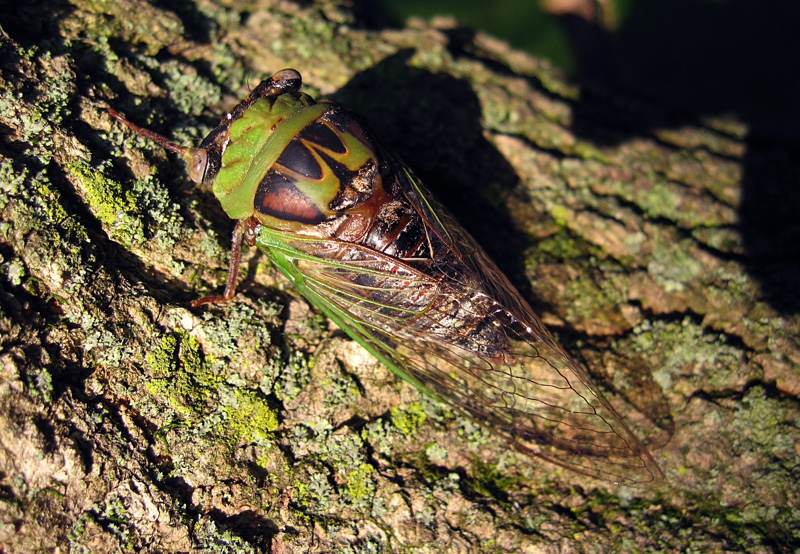
Megatibicen pronotalis photo by Roy Troutman, taken in Batavia, Ohio.
According to the book Australian Cicadas by M.S. Moulds (New South Wales University Press, 1990) Cyclochila australasiae and Thopha saccata reach nearly 120db at close range. The “at close range” might be the key difference in measuring the sound, as Petti measured at a distance of 50cm.
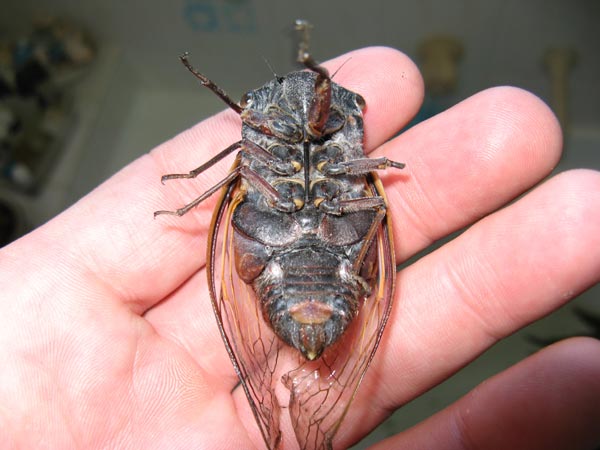
Double Drummer (Thopha saccata), a cicada found in Australia, can reach 120db at close range. Photo by Kevin Lee.
Personally, I’ve observed Magicicada cassini choruses achieve between 85 & 86 decibels (link to video), and M. cassini responding to fingersnaps (mimics female wing flicks) at as high as 116 decibels (link to video) 35s in). The 116 decibels level was recorded with the insect standing on the microphone of my Extech 407730. Magicicada choruses have been documented to reach 100 decibels
Magicicada chorus at around 80db:
Some people want to know how loud a cicada can get just because it is a cool fact to know, but others are concerned about noise-induced hearing loss (about which, I am not an expert). Both decibels and prolonged exposure seem to matter. According to the National Institute on Deafness and Other Communication Disorders page on Noise-Induced Hearing Loss, prolonged exposure to sounds over 85db can cause hearing loss (just above the chorus of a Magicicada). The WebMD harmful noise levels page has chainsaws and leaf blowers in the range of the loudest cicadas. Lessons learned: 1) Make sure you wear hearing protection if you plan on blowing leaves or searching for the loudest cicada, and 2) Do not complain about the cicadas in your yard — complain about your neighbors and their leaf blowers.
Male cicadas, in case you were wondering, use their opercula (flaps on their abdomen) to cover their tympana (the cicadas hearing organs) when they sing, so they don’t damage their own hearing. Cicadas — male and female — listen with their tympana.
Paul Krombholz has come through with an awesome guide to identifying Tibicens just after they have molted. Click the image below for an even larger version. Note that the genus of these cicadas has changed to either Megatibicen or Neotibicen — notes below.
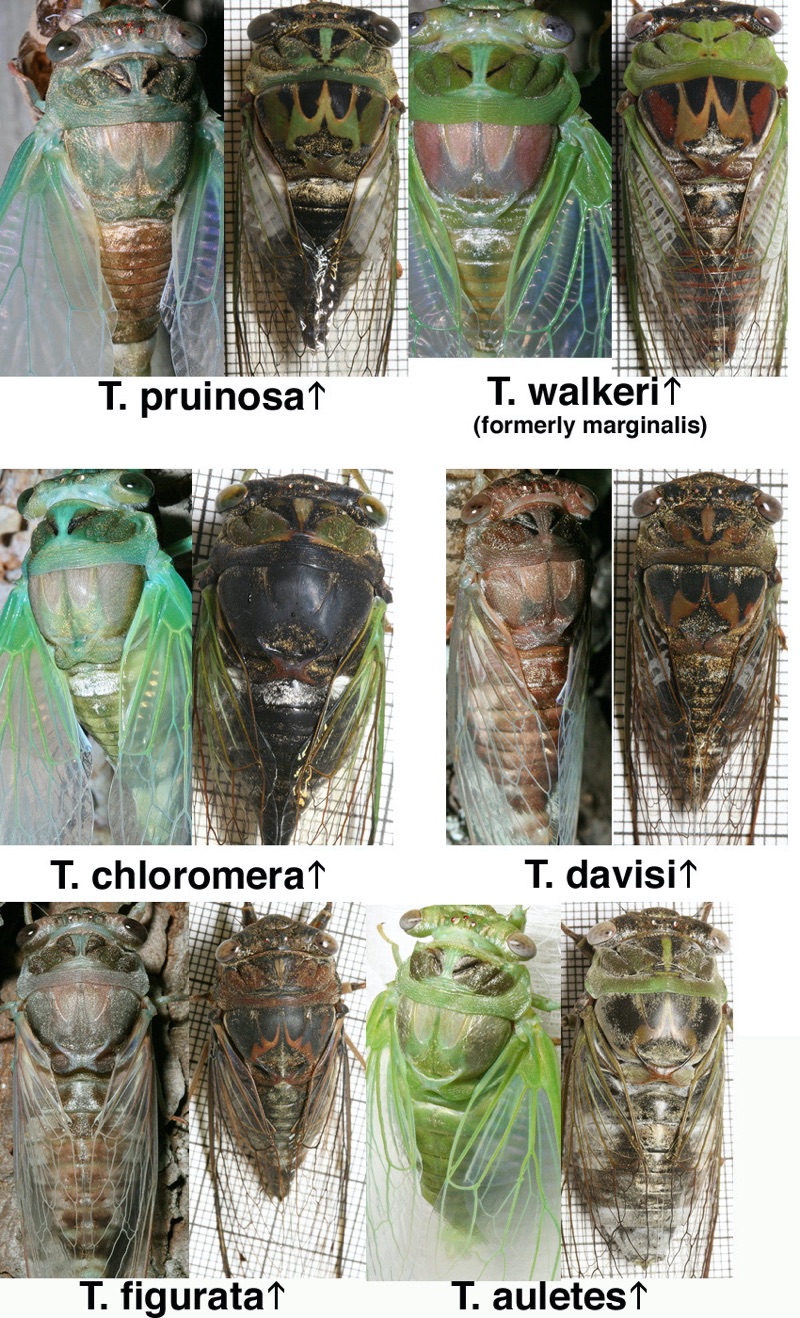
Notes on the species from Paul:
N. pruinosus [formerly T. pruinosa]—Newly molted adult has darker mesonotum (top of mesothorax) than the very common T. chloromera. Abdomen is a golden orange color. Older adult has dark olive on lateral sides of mesonotum, lighter green below the “arches”.
M. pronotalis (formerly walkeri, marginalis)—Quite large. The reddish brown color can be seen on the mesonotum of newly molted adult. Older adult has solid green pronotum (top of prothorax) and red-brown markings on sides of mesonotum. Below the “arches” the mesonotum color can range from carmel to green. Head is black between the eyes.
N. tibicen [T. chloromerus, T. chloromera]—has large, swollen mesonotum, quite pale in a newly molted adult and almost entirely black in an older adult. Individuals from east coast can have large russet patches on sides of mesonotum. The white, lateral :”hip patches” on the anteriormost abdominal segment are always present, but the midline white area seen in my picture is sometimes absent.
N. davisi—Small. This is a variable species, but all have an oversized head that is strongly curved, giving it a ‘hammerhead’ appearance. Newly molted individuals are usually brown with blueish wing veins that will become brown, but some have more green in wing veins. Some may have pale mesonotums that will become mostly black. Older adults vary from brownish to olive to green markings on pronotum and mesonotum.
M. figuratus [formerly T. figurata]—a largish entirely brown cicada. Newly molted adult has a pink-brown coloration with some blueish hints. Older adult has chestnut-brown markings and no green anywhere. The Head is not very wide in relation to the rest of the body. The small cell at the base of the forewing is black.
M. auletes—a large, wide-bodied cicada. The newly molted adult is very green, but the older adult loses most of the green, usually retaining an olive posterior flange of the pronotum. The dorsal abdomen of the adult has a lot of powdery white on the anterior and posterior segments with a darker band in between.
From my own photos, here’s a sequence of photos of a Neotibicen tibicen tibicen as its colors develop.
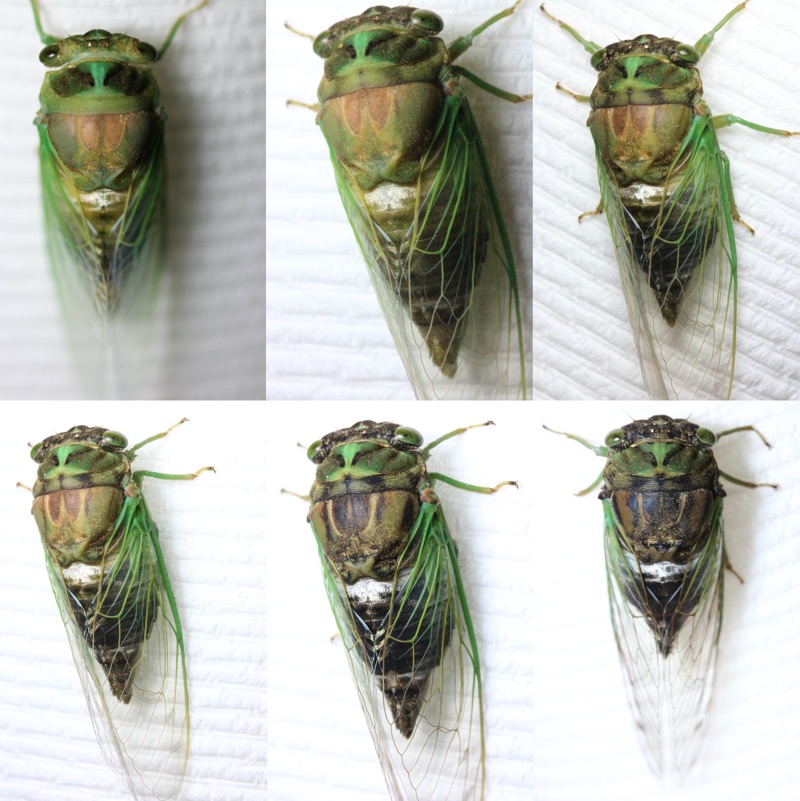
Here’s a comparison of two teneral Neotibicen linnei. Note the variation in colors — one green, one pink — from the same grove of trees in New Jersey. Color can vary a lot!
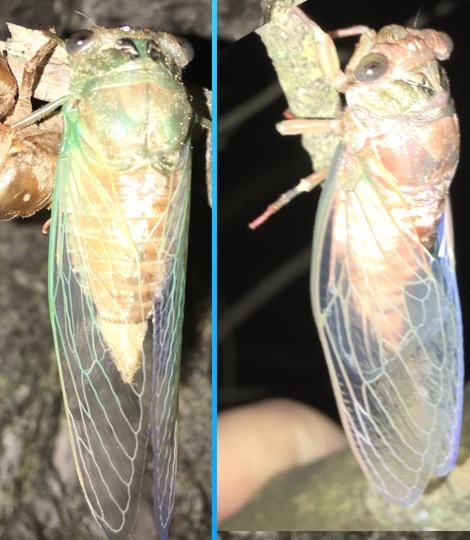
Iván Jesús Torresano García send us a dozens of cicada photos from Spain, where he resides. According to Iván June is a peak time for cicadas in Spain. Cicadas common to the area are: Cicada orni, Lyristes (old Tibicen) plebejus, Tettigetta argentata, Hilapura varipes, Euryphara contentei (miniature), Tibicina tomentosa, and finally the brownish “Barbara Lusitanica Cicada”.
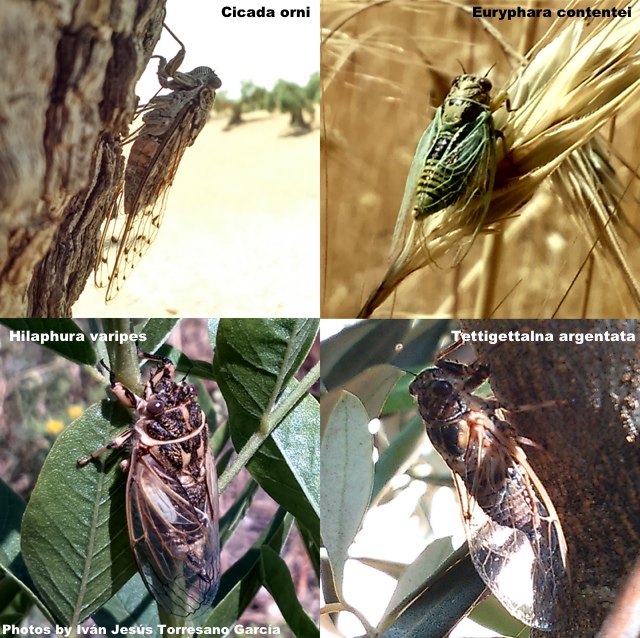
Galleries:
Here are some of these cicadas captured by Iván.
Cicada orni:
Cicada orni is one of the most common cicadas in Spain and all of Europe. The are incredibly well camouflaged.
Tettigettalna argentata:
Hilaphura varipes:
Euryphara contentei:
For more information of the cicadas of Spain, visit Songs of European Singing Cicadas.